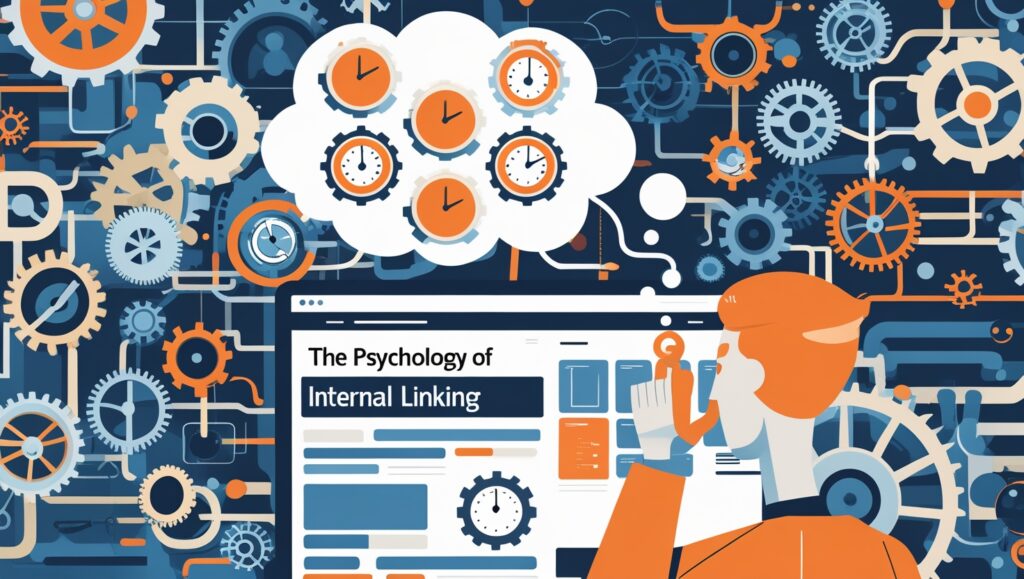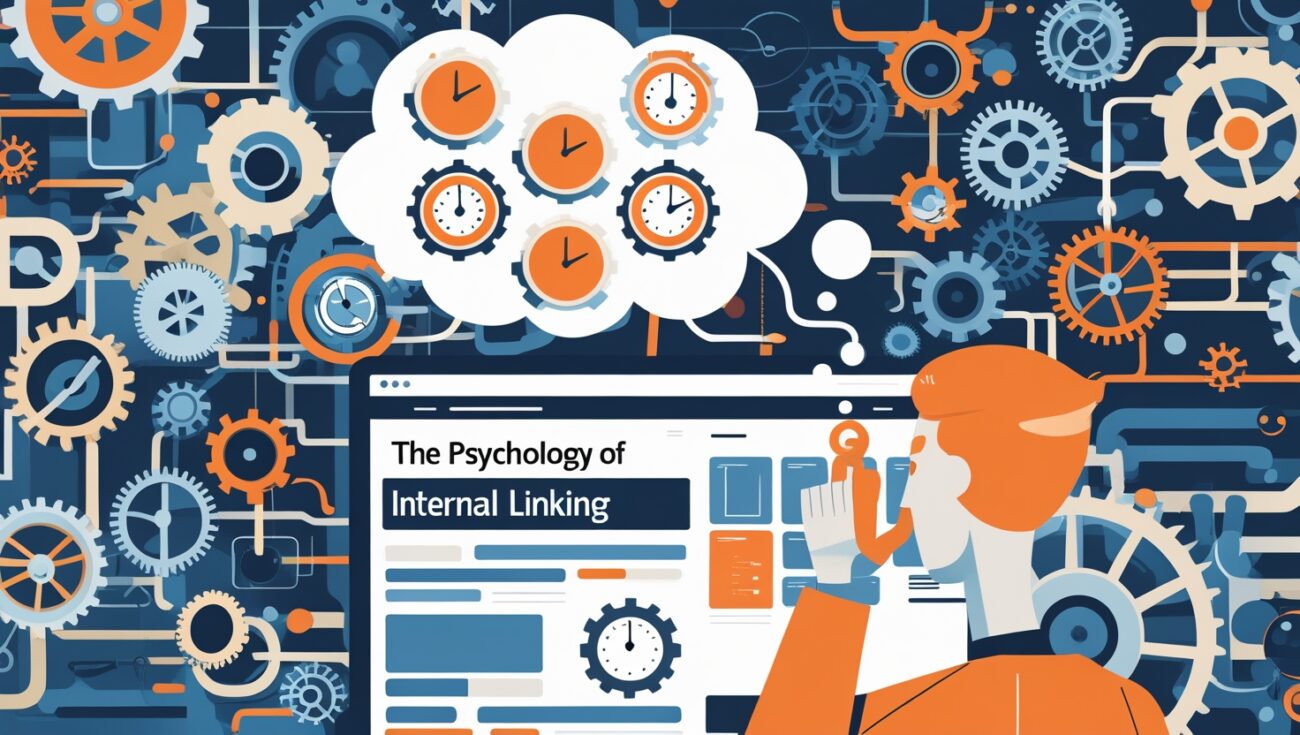The Psychology of Internal Linking: Why Users Click and Stay
I used to think that the most important part of SEO was the technical stuff—keywords, meta tags, and backlinks. But I’ve since learned that the most powerful SEO is often about understanding people. It’s about figuring out what they want, how they think, and what makes them feel safe and comfortable on a website.

Table of Contents
I’ve come to believe that internal linking is the bridge between technical SEO and a great user experience. A strategically placed link is more than just a vote of confidence for a page; it’s a subtle psychological cue that tells a user, “I understand what you need, and here’s the best way to get it.” If you’re ready to start building a website with empathy, this guide is for you.
The Trust Signal
A clean, logical website structure builds trust. Think about the last time you landed on a cluttered, confusing website. You probably left almost immediately. Now, think about a website that feels professional and easy to navigate. You are more likely to stay, to browse, and to trust the information they provide.
- The Goal: A user’s brain processes a well-linked site as a professional, trustworthy resource. When a link is relevant and helpful, it makes the user feel like you understand their needs. It builds credibility and makes them more likely to trust your content, your products, and your brand.
The Two Core Psychological Principles
- Principle #1: The Curiosity Loop. A good internal link creates a “curiosity loop.” It answers one question while simultaneously presenting another, related question that the user wants to explore. For example, if a user is reading a guide on “how to start a podcast,” a link to “the best podcasting microphones” is a natural next step. This keeps them on the site, satisfying their curiosity and making them feel like they’re on a journey of discovery.
- Principle #2: The Path of Least Resistance. Humans naturally seek the path of least resistance. A user who lands on your site from a search engine has a problem, and they want the easiest way to solve it. A strategic internal link provides that path, guiding a user to the next piece of content they want, without forcing them to go back to a search engine. This reduces bounce rate and increases time on page, which are powerful signals to Google.
The Psychological Internal Linking Playbook
Action 1: Use Enticing, Benefit-Driven Anchor Text
The anchor text you use is a powerful psychological tool. Instead of generic phrases like “click here,” use a phrase that sparks curiosity and promises more value. For example, “read our full guide on podcasting microphones” or “discover how to edit your first episode” are far more enticing and effective.
Action 2: Link to Answer Their Next Question
Put yourself in the user’s shoes. What is the logical next question they will have? Link to the content that answers it. This shows empathy and tells the user that you are an expert who understands their needs. A tool can find all of these natural, high-impact opportunities for you in minutes.
Action 3: Make it a Habit of Empathy
A great internal linking strategy is not a one-time project; it’s an ongoing habit of putting yourself in the user’s shoes. It’s about consistently asking, “What is the most helpful thing I can link to from this page?” This simple habit will transform your website’s performance.
The Tool That Automates Empathy
Manually managing all of the above is a monumental task. How do you find all the perfect places to link to and from? The truth is, you don’t have to. Internal linking automation can scan your entire site and provide you with a clear, actionable list of every opportunity and issue, taking the guesswork out of the process. Ready to build a website that’s optimized for both search engines and humans? Discover how Linkbot can help you.
Conclusion: Link with Purpose
Understanding the psychology of internal linking is the key to creating a website that users love and trust. By linking with purpose and empathy, you can create a powerful, user-friendly website that is perfectly optimized for how people think. It’s the most effective way to build a high-ranking website and grow a loyal audience.
My journey taught me that a major mistake is seeing SEO as a mystery. By implementing a smart, corrective approach to my website, I made the mental shift from being a spectator to an active participant in my website’s success. This simple realization took the overwhelm out of SEO and turned it into a series of logical, manageable steps that I could control.
The long-term, compounding effect of fixing these mistakes is what makes it so powerful. Each time you add a thoughtful, relevant link, you are not just performing a task; you are building your website’s authority, one link at a time. These small, consistent improvements add up to a significant competitive advantage over the long term, making your website an increasingly powerful asset.
I can say from personal experience that there is a special kind of satisfaction that comes from seeing a direct correlation between a new link and a ranking boost. It’s the feeling of taking a tangled mess and organizing it into a clean, logical network. The result is a website that just feels better to navigate, for both users and the people managing it.
A clean internal link profile also has a huge impact on your website’s overall trustworthiness and authority. When a user or a search engine bot lands on your page and sees a clear network of interconnected, relevant articles, it signals that you are a serious, comprehensive resource on the topic. This kind of professional organization is exactly what Google looks for.
The most important part of this foundational skill is building a consistent habit of linking. It’s not about a single audit and then forgetting about it. A good website is a living thing, and it needs regular maintenance to ensure your internal links stay clean, which is a key part of long-term SEO success.
I felt like I was finally in the driver’s seat of my SEO. For years, I had relied on external factors, which felt like I was giving up control of my SEO destiny. But by mastering a simple task like building my internal links, I was proactively building my site’s authority from the inside out, on my own terms, which was an empowering and exciting feeling.
By implementing a strategy that serves both SEO and conversions, you are also directly addressing Google’s E-E-A-T framework. You are demonstrating expertise by creating topical clusters, you are showing authority by linking from strong pages, and you are providing a better user experience, which is a key part of what Google looks for in a trustworthy website.
I’ll never forget the first time I applied my new internal link strategy to a page that was struggling to rank, and it shot up in the search results almost overnight. This was my “aha” moment. I realized that a strategic, well-placed link from a high-authority page was far more powerful than I ever thought possible.
One of the greatest benefits I got from using an automated tool to manage my link profile was the “to-do” list it provided. Instead of being overwhelmed by the sheer size of my website, the tool gave me a prioritized, actionable list of fixes to make. It transformed a monumental, frustrating task into a series of manageable steps that I could tackle in just minutes.
It’s crucial to understand the difference between a simple, generic link and one that’s part of a strategic, mapped plan. A simple link is a one-off connection. A link that’s part of a plan is a purposeful part of a larger network, designed to pass authority and guide a user. The latter is far more powerful.
Ultimately, mastering internal linking is a simple but powerful strategy that transforms a website’s foundation. It’s a low-cost, high-impact fix that can instantly improve your site’s health and SEO performance. It’s the kind of foundational SEO work that every website owner should prioritize.
My final piece of advice is to not be intimidated. Don’t worry about the high cost of manual labor; just focus on making your website a better place for your readers. You will be amazed at the progress you make and the results you can achieve.

